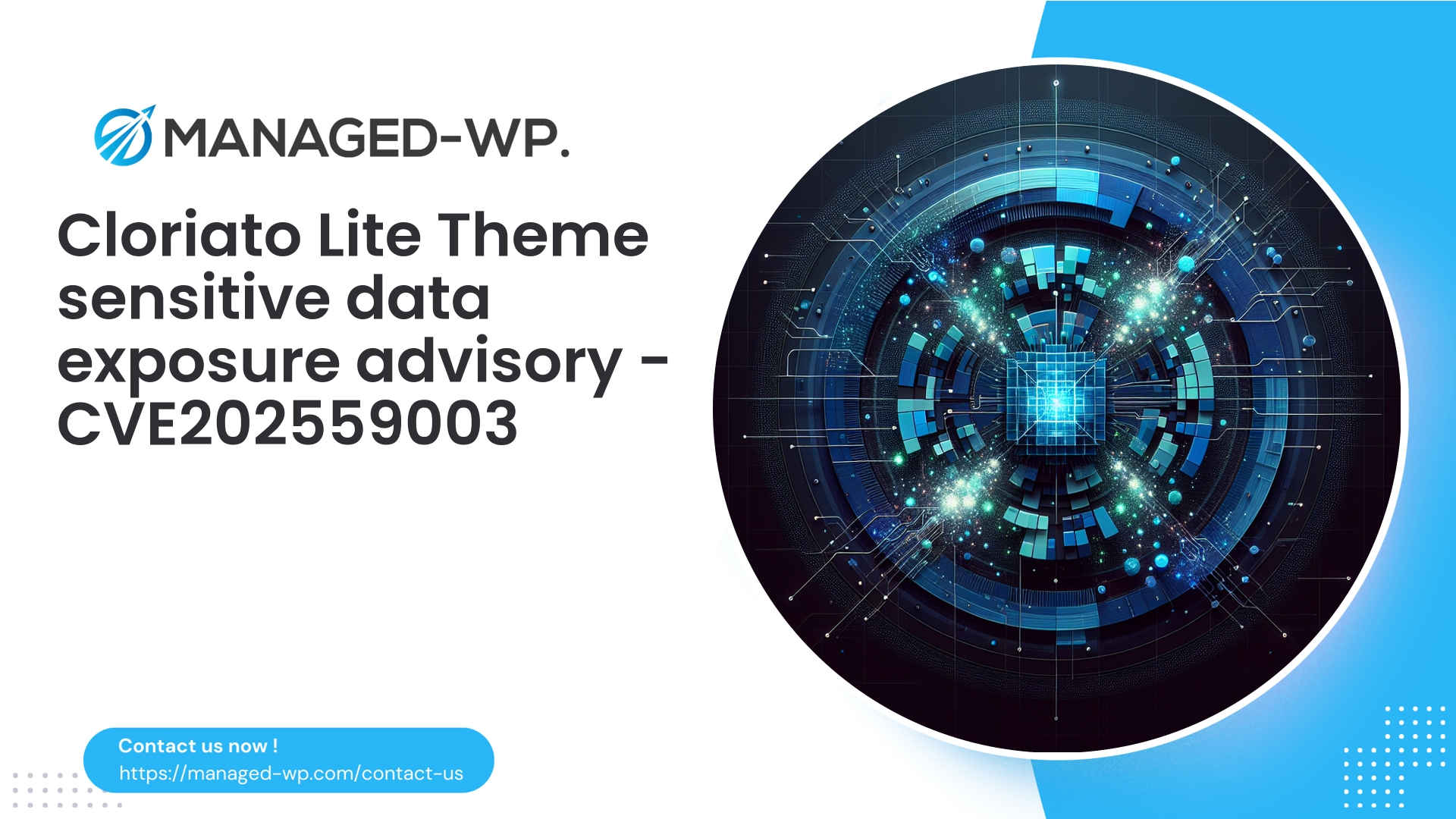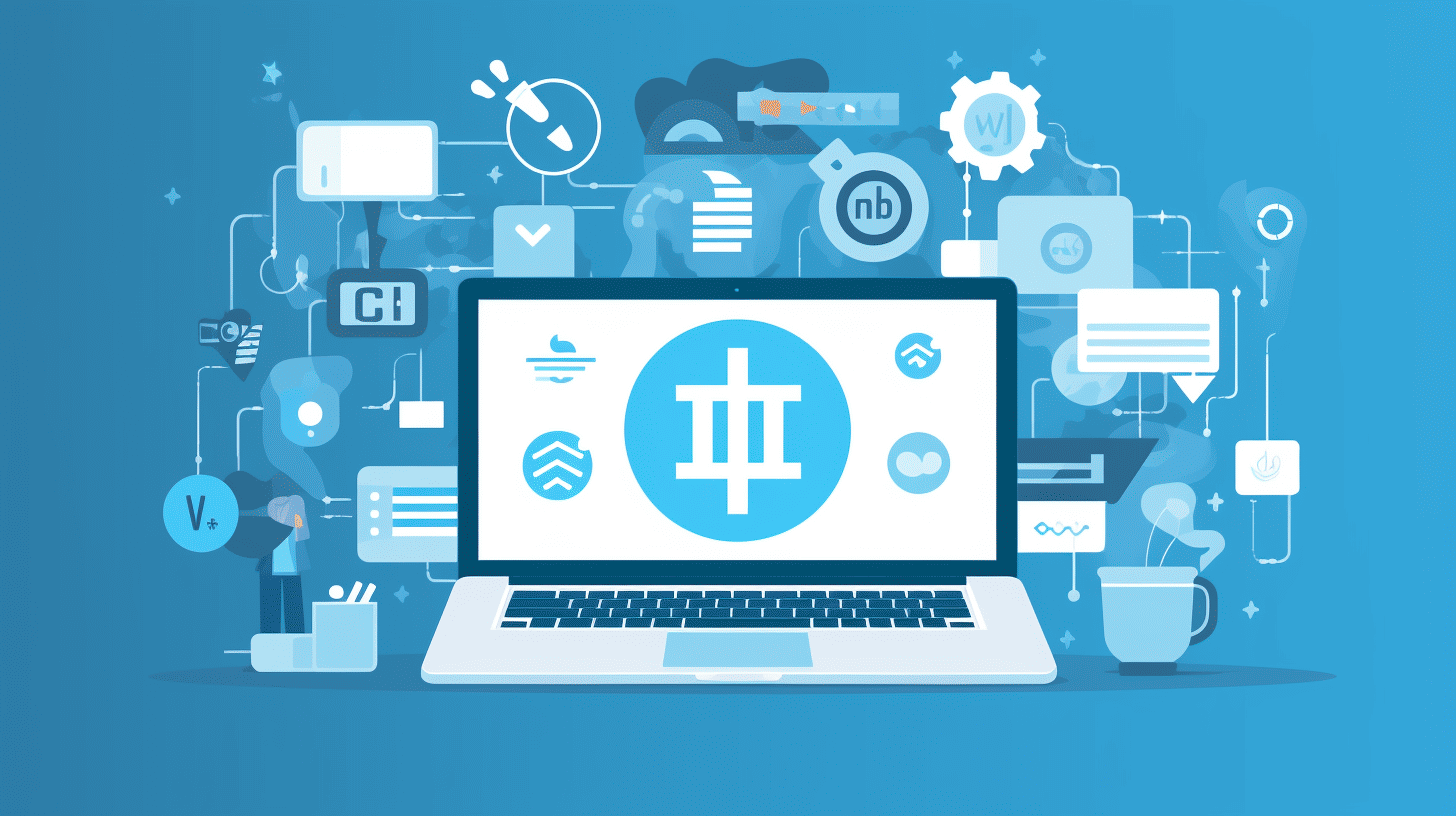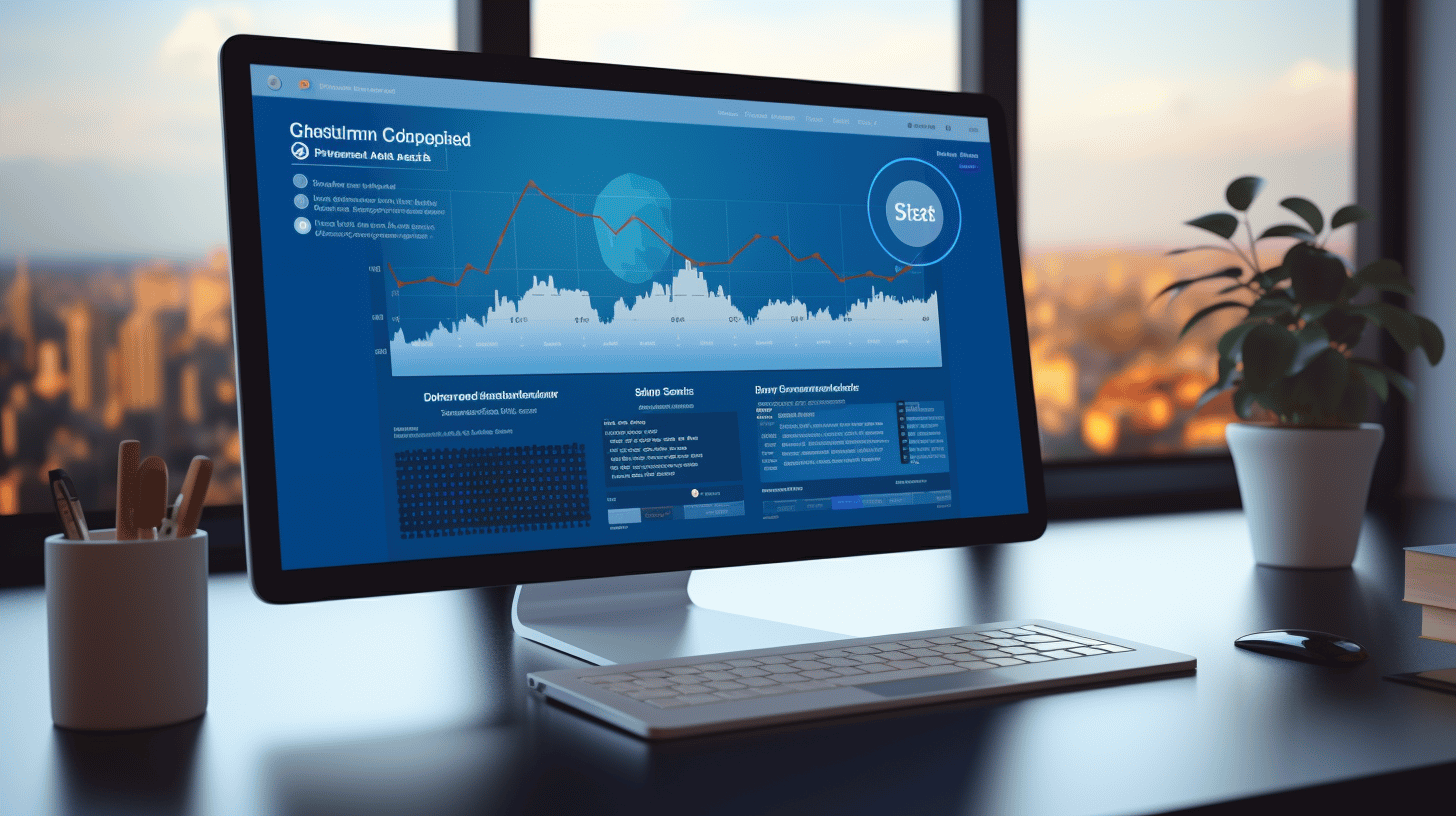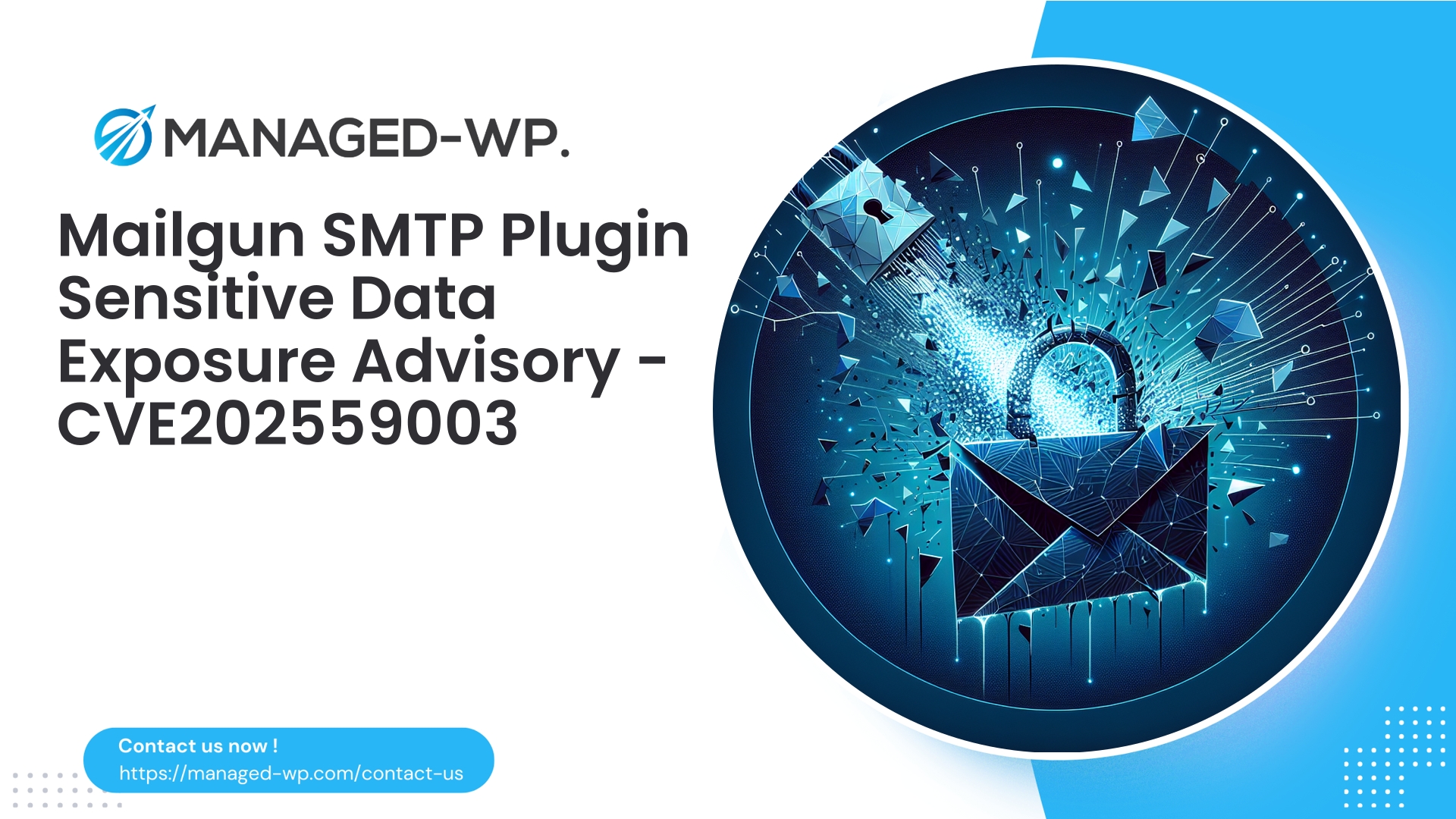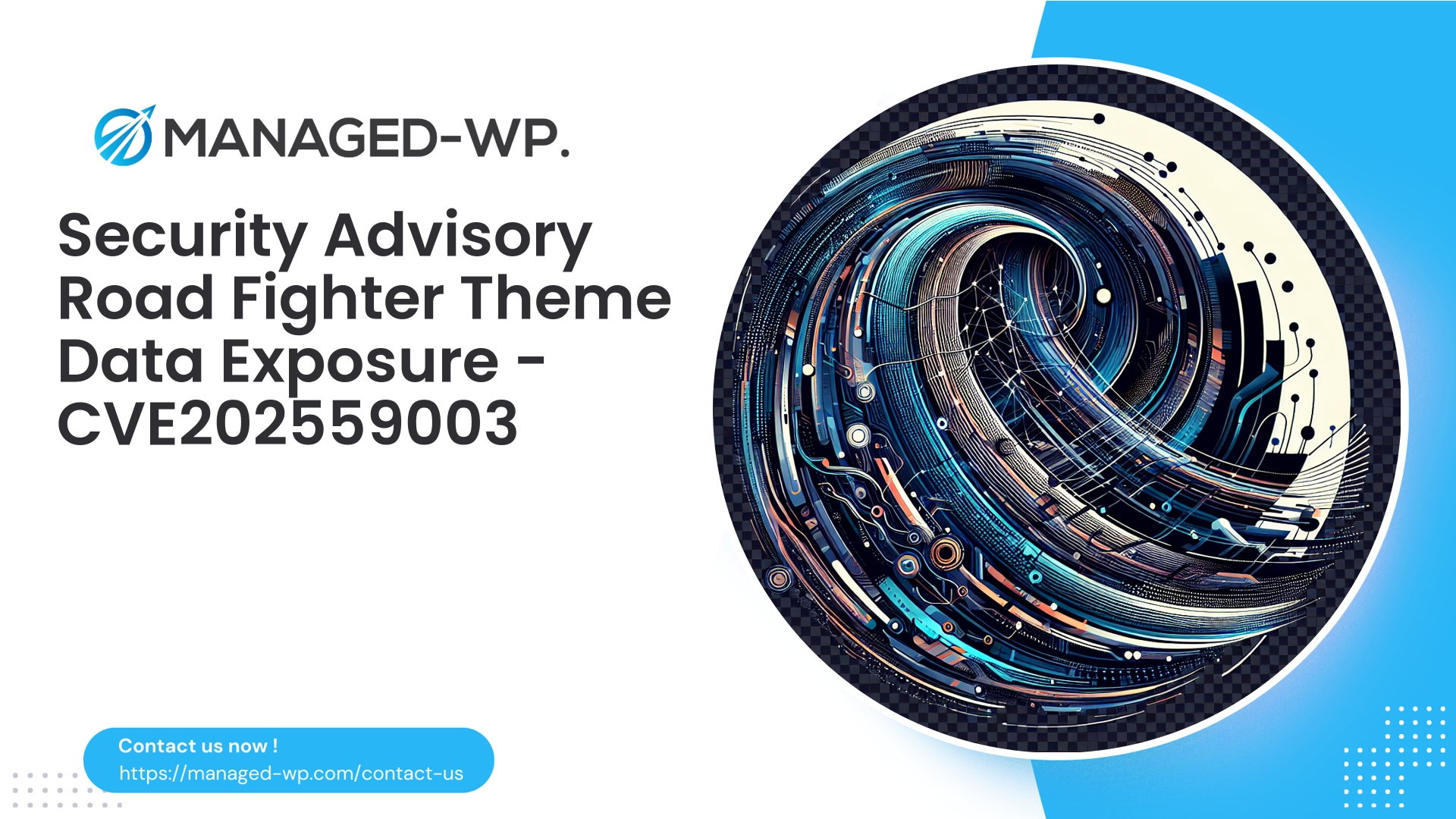| 插件名称 | 克洛里亚托淡味 |
|---|---|
| 漏洞类型 | 数据泄露 |
| CVE编号 | CVE-2025-59003 |
| 紧急 | 低的 |
| CVE 发布日期 | 2025-09-12 |
| 源网址 | CVE-2025-59003 |
WordPress 运维人员重要提示:Cloriato Lite 主题敏感数据泄露 (CVE-2025-59003)
如果您的 WordPress 环境使用的是 Cloriato Lite 主题 1.7.2 或更早版本,请注意:该主题存在一个敏感数据泄露漏洞,并已公开披露。该漏洞编号为 CVE-2025-59003,允许未经身份验证的攻击者访问本应保密的数据。虽然该漏洞的 CVSS 评分为 5.8(中等),且被列为低优先级,但由于没有发布任何厂商补丁,且该主题似乎已被放弃维护,因此受影响安装的风险等级仍然较高。
本安全公告由 Managed-WP 安全专家发布,旨在为网站管理员、开发人员、托管服务提供商和网络安全团队提供专业的美国安全视角。以下内容将详细解释漏洞、潜在攻击途径、检测指标、实用缓解措施(包括通过 Web 应用防火墙进行虚拟修补)以及长期解决方案指南。
关键细节概述
- 漏洞类型: 敏感数据泄露(OWASP 分类为 A3 级——敏感数据泄露)
- 受影响版本: Cloriato Lite 版本 1.7.2 及更早版本
- CVE标识符: CVE-2025-59003
- 需要身份验证: 无(无需登录即可利用此漏洞)
- 补丁状态: 目前没有官方补丁;该主题似乎已被弃用。
- 风险评估: 未经授权的数据访问可能导致下游安全漏洞,例如账户盗用、有针对性的网络钓鱼活动或数据窃取。
- 建议立即采取的行动: 加强访问控制,部署基于WAF的虚拟补丁,轮换暴露的凭据,并启动主题更换计划
了解此次敏感数据泄露的性质
“敏感数据泄露”泛指受保护信息(包括 API 密钥、用户详细信息、内部配置设置或身份验证令牌)可能被未经授权方访问的情况。与严重的远程代码执行漏洞不同,此漏洞主要泄露攻击者可间接利用的信息,从而入侵您的 WordPress 环境。
- 暴露 API、SMTP 或其他集成凭据
- 内部笔记、电子邮件地址、订单信息或数据库用户详细信息的泄露
- 泄露调试信息、文件路径和系统用户名
- 支持攻击者的侦察和攻击链策略
由于利用此漏洞无需身份验证,攻击者可以直接探测您的网站。尽管漏洞严重性评级较低,但由于其易于访问,可能会造成严重的后续后果。
利用场景和威胁载体
- 信息侦察: 攻击者分析主题端点,以窃取配置详细信息、内部数据或可能包含敏感凭据的源文件。
- 凭证窃取和横向攻击: 提取的密钥或凭证可能被用于发送钓鱼邮件、访问第三方集成或扩大入侵范围。
- 用户隐私侵犯: 提取电子邮件地址和用户数据会导致有针对性的社会工程攻击和隐私泄露。
- 升级为严重违规: 获取的信息可以用于暴力破解或凭证填充攻击,从而导致账户被盗或网站完全控制。
您的网站可能已被入侵或遭受攻击的迹象
监测项目:
- 针对特定主题端点的异常请求(例如,包含以下内容的 URL)。
/wp-content/themes/cloriato-lite/)带有非典型查询参数或 POST 数据 - 来自陌生 IP 地址的重复访问,用于检索主题资源或 JSON 端点
- 针对通常受保护或非公开的文件,出现“200 OK”响应数量意外激增的情况。
- 未经授权创建管理员用户
- 异常的 SMTP 活动或出站连接表明凭据被滥用
- 在日志或前端内容中发现暴露的 API 密钥、数据库标识符或用户电子邮件
出现任何这些迹象都应立即启动事件响应和控制程序。
紧急缓解措施(未来 24 至 72 小时)
- 受影响的库存安装:
– 在活动站点、备份和测试环境中搜索 Cloriato Lite 主题版本 1.7.2 或更早版本。
– 对于多站点环境,自动扫描文件系统以检测主题签名。 - 考虑暂时关闭网站:
– 如果怀疑网站遭到入侵,则将网站置于维护模式,以最大限度地减少数据泄露,同时应对威胁。 - 通过WAF实现虚拟补丁:
– 部署规则阻止对已知易受攻击的主题端点的可疑请求,从而即使没有官方补丁也能立即防止利用。 - 限制对主题 PHP 文件的访问:
– 使用服务器级控制(Apache/nginx)阻止直接公开访问 Cloriato Lite 主题目录中的 PHP 文件。 - 轮换凭证和密钥:
– 重新生成所有 API 密钥、SMTP 凭据、WordPress 管理员密码和其他可能泄露的机密信息。 - 进行全面的入侵扫描:
– 对文件和数据库进行彻底的恶意软件扫描;查找后门、非法管理员用户、可疑的计划任务和 PHP 注入。 - 计划主题迁移:
– 鉴于主题已被弃用且存在风险,应优先迁移到安全、积极维护的主题。
推荐的技术控制措施:WAF 规则示例
以下是一些用于缓解此漏洞的 WAF 规则示例,可根据您的环境进行调整。在强制执行严格阻止之前,请务必先在监控模式下进行测试,以避免误报:
- 阻止在主题文件夹内直接执行 PHP 请求:
匹配 URI 包含的请求/wp-content/themes/cloriato-lite/最后以……结尾.php. - 阻止泄露内部设置的可疑 JSON 或 AJAX 请求:
匹配 URI 模式,例如/wp-content/themes/cloriato-lite/.+\.json或包含以下内容的查询字符串操作=获取主题选项. - 筛选侦察查询字符串:
阻止或质疑带有查询参数的 GET 请求,例如调试,配置,选项,秘密,令牌,钥匙, 或者smtp. - 实施速率限制:
限制主题端点每 10 秒的请求次数超过 5 次。 - 屏蔽已知的恶意用户代理和可疑 IP 地址:
拒绝被识别为源自扫描器或无来源来源且显示侦察模式的请求。
Managed-WP 客户可以利用专家协助,无缝地定制和部署这些保护措施。
服务器级加固建议
- Apache 配置(例如,.htaccess):
拒绝命令,允许拒绝所有
(请确保根据需要将 admin-ajax.php 等合法请求加入白名单。)
- nginx 规则示例:
location ~* ^/wp-content/themes/cloriato-lite/.*\.php$ { deny all; return 403; }
- 其他最佳实践:
- 在生产环境中禁用 WP_DEBUG 和 WP_DEBUG_LOG 以防止信息泄露。
- 强制执行安全的文件权限(例如,文件权限 644,目录权限 755)。
- 如果未使用 XML-RPC,则限制或禁用 XML-RPC 以减少攻击面。
日志监控:需要关注的模式
- 频繁使用 GET 请求获取带有查询参数的 PHP 主题文件。
- 使用可疑查询键进行访问尝试,例如
配置=1,debug=1,选项=全部. - 请求包含关键字“theme”、“options”或“settings”的 JSON 端点或 URL。
- 没有包含奇怪或通用用户代理字符串的引用标头。
- 200 HTTP 状态码异常增加,导致通常受限的文件无法正常使用。
在日志记录或 SIEM 系统中配置警报,以便及时检测和响应。
疑似入侵事件响应工作流程
- 启用维护模式或移除公共访问权限,隔离受影响的系统。
- 保存并妥善保管所有日志、备份和系统快照。
- 创建用于详细分析的磁盘和文件取证备份。
- 轮换所有相关凭证,包括 WordPress 帐户、API 密钥、数据库和主机凭证。
- 对入侵指标进行深度扫描,包括未经授权的管理员帐户和注入的代码。
- 将代码和资产与可信基线或干净的备份进行比较。
- 根据调查结果清理或恢复系统。
- 实施严格的访问控制措施,例如多因素身份验证和最小权限原则。
- 部署虚拟补丁和强化服务器策略。
- 修复后继续密切监测异常活动。
如有必要,聘请专业的事故响应服务机构进行深入调查和恢复。
长期补救策略
由于没有官方补丁且主题已弃用,建议替换 Cloriato Lite。请考虑以下几点:
- 采用安全、积极维护的主题
可享受定期安全更新和社区或供应商支持;可能需要进行设计和兼容性调整。 - 分叉和内部维护
完全掌控主题代码,但需要持续开发和安全监督。 - 利用基于受支持框架的子主题
允许自定义样式,同时利用安全且维护良好的父主题。
在正式部署之前,务必在测试环境中对任何新主题进行彻底测试,确保其兼容性和用户体验良好。
利益相关者沟通指南
- 问题概要: “Cloriato Lite 主题存在漏洞,可能导致未经授权访问内部网站信息。”
- 已采取的行动: “在进行扫描期间,已采取临时保护措施,由于缺乏可用的修复方案,更换计划正在进行中。”
- 当前影响: “未检测到已确认的数据泄露;为安全起见,敏感凭证正在轮换使用。”
- 后续步骤: “我们将发布更新信息以及主题迁移的时间表。”
信息传递要简洁明了,重点在于通过明确的行动计划来增强客户的信心。
安全最佳实践和加固检查清单
- 仅部署具有有效安全维护功能的主题和插件。
- 保持 WordPress 核心程序、主题和插件完全更新。
- 使用具备虚拟修补功能的托管式 Web 应用程序防火墙 (WAF)。
- 贯彻最小权限原则;要求管理员用户使用强密码和双因素身份验证。
- 将 API 密钥和凭据轮换并安全地存储在主题文件之外。
- 禁用仪表板内文件编辑功能
定义('DISALLOW_FILE_EDIT',true);. - 维护符合安全策略的受监控备份。
- 定期扫描恶意软件和入侵指标。
- 实现安全 HTTP 标头,例如 Content-Security-Policy 和 X-Content-Type-Options。
- 建立日志监控机制,并对异常流量发出警报。
当没有官方修复程序时,虚拟修补的重要性
当供应商未能提供补丁且切换主题需要时间时,通过 Web 应用防火墙 (WAF) 进行虚拟修补至关重要。它可以在恶意请求到达生产代码之前拦截并阻止针对漏洞的恶意请求,从而使您能够:
- 迅速调查并识别正在发生的网络攻击企图。
- 安全地准备分阶段迁移或更新流程。
- 轮换凭证,提升整体环境安全性。
虚拟修补是一种遏制措施,不能替代正规修补,但对于立即降低风险至关重要。
Managed-WP 专家建议:部署针对 CVE-2025-59003 的 WAF 规则
- 部署前验证:
以仅监控/检测模式执行规则 24-48 小时;验证合法端点以避免中断。 - 严格封锁:
禁止对主题文件夹内所有不必要的直接 PHP 文件访问,并阻止侦察查询模式。 - 限速和挑战机制:
对重复请求实施速率限制,并对可疑客户端实施验证码。 - 告警和日志记录:
触发规则后立即生成警报,包括详细的请求分析,以便快速响应。
Managed-WP 客户可获得个性化的虚拟补丁部署和迁移咨询服务。
迁移规划:最大限度减少站点中断
- 审核现有主题的所有功能依赖项(小部件、短代码、模板)。
- 建立一个试验环境,以便安全地试用新主题。
- 记录基线屏幕截图、结构和内容流程以进行验证。
- 将自定义样式/脚本隔离到子主题或专用插件中。
- 彻底测试关键工作流程(表单、结账、用户身份验证)。
- 在客流量低谷时段安排换班,并提前通知用户。
- 保留旧主题以供离线参考,但避免重新激活。
常见问题
问:CVSS评分为5.8,真的有必要采取行动吗?
答:绝对如此。即使是程度较轻、未经认证的数据泄露,也可能助长严重的攻击。官方缺乏修复措施会加剧风险。
问:删除主题文件就足够了吗?
答:仅移除使用记录是不够的。请确保所有主题文件,包括备份和测试副本,都已安全移除。
问:虚拟修补程序会不会影响我的网站?
答:虚拟补丁需要仔细调整和测试,以避免误报。Managed-WP 虚拟补丁经过精心设计,可最大限度地减少影响。
快速事件响应检查表
- 找出所有运行 Cloriato Lite ≤ 1.7.2 的 WordPress 实例。
- 根据需要将可疑站点置于维护模式。
- 以检测然后阻止模式部署 WAF 虚拟补丁。
- 分析访问日志,查找针对该主题的可疑请求。
- 全面轮换可能已被泄露的凭证。
- 执行恶意软件扫描和完整性检查。
- 用安全的替代方案替换存在漏洞的主题。
- 对修复后的场地进行至少 30 天的监测。
使用 Managed-WP 保护您的 WordPress 网站
使用 Managed-WP 的防火墙和防护服务,几分钟内即可获得必要的安全保障
为了在制定长期计划的同时立即降低风险,Managed-WP 提供全面的防火墙解决方案,包括托管式 Web 应用程序防火墙控制、恶意软件扫描和 OWASP Top 10 漏洞防护——所有这些都旨在阻止诸如 Cloriato Lite 数据泄露之类的漏洞。快速激活必要的保护措施,守护您的网站安全:
https://managed-wp.com/contact
升级选项包括高级虚拟补丁、IP 允许/拒绝控制和详细报告,以大规模地维持强大的、可管理的安全。
来自托管 WordPress 专家的最终安全见解
这一事件凸显了两个至关重要的原则:
- 始终优先选择维护活跃且符合安全开发标准的插件和主题。
- 实施稳健的多层防御措施,包括持续监控、虚拟修补和快速事件响应能力。
Managed-WP 可协助企业评估广泛存在的安全风险,实施定制化的虚拟补丁,并规划安全的主题迁移。采用托管安全框架仍然是抵御机会主义攻击的最佳防线。
使用 Managed-WP,保持警惕并确保安全——您积极主动的 WordPress 安全合作伙伴。
— Managed-WP 安全团队











